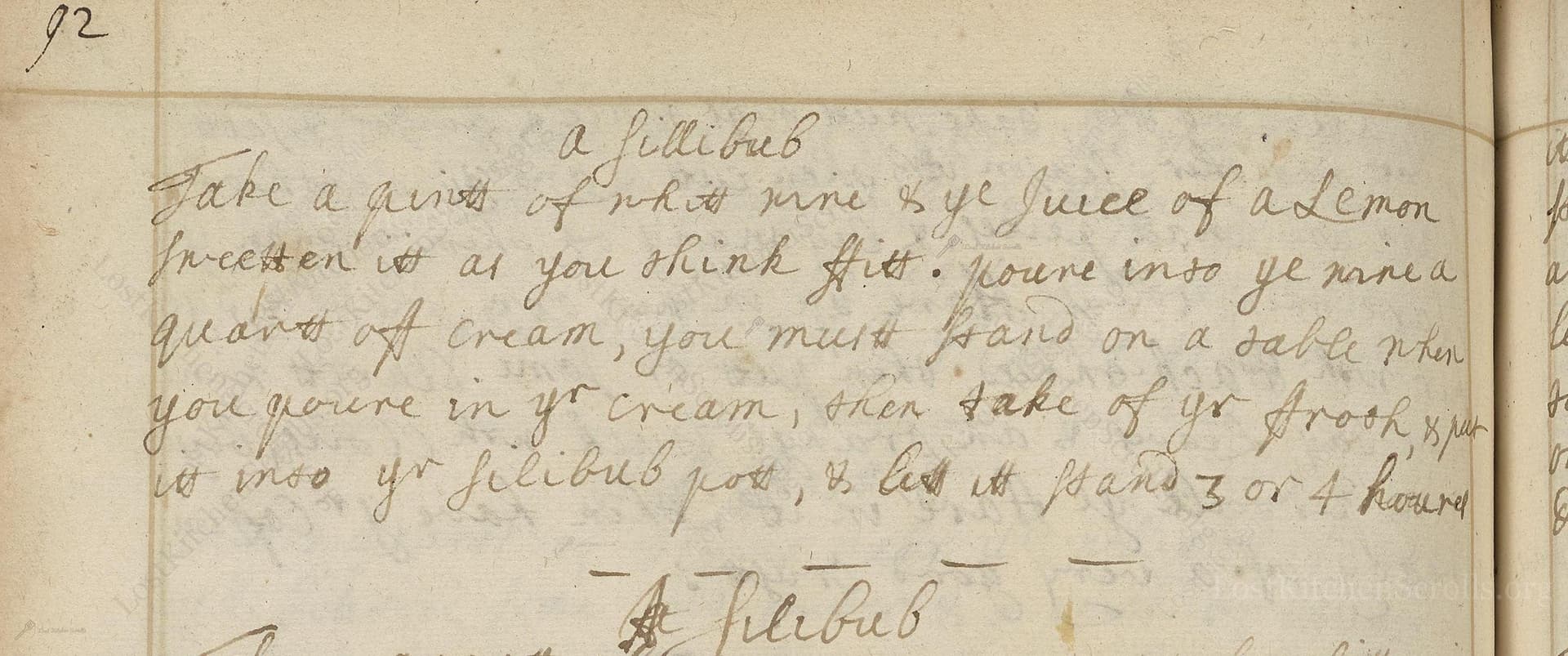A Fillibub
From the treasured pages of Receipt book of Mary Hookes
Written by Mary Hookes

A Fillibub
"Take a pintt of whit wine & ye Juice of a Lemon sweeten itt as you think fitt. poure into ye wine a quartt off cream, you must stand on a table when you poure in yr cream, then take of yr frosh & putt itt into yr fillibub pott, & lett itt stand 3 or 4 houres."
Note on the Original Text
The recipe is written in an informal, conversational 17th-century style, with inconsistent spelling typical of the period: 'pintt', 'quarrt', 'frosh', and 'itt' for 'pint', 'quart', 'froth', and 'it'. Directions were often brief and assumed prior experience in the kitchen. Quantities and sweetness were left to the cook's judgment, and ingredients were described in everyday language. The performance aspect—standing on a table to pour—was as much about fun and flair as it was about achieving a light, foamy result.

Title
Receipt book of Mary Hookes (1700)
You can also click the book image above to peruse the original tome
Writer
Mary Hookes
Era
1700
Publisher
Unknown
Background
A delightful voyage into the kitchens of the late 17th and early 18th centuries, this book teems with forgotten flavors, aromatic recipes, and the elegant wisdom of early modern cookery. A treasure trove for culinary adventurers craving a taste of the past!
Kindly made available by
Folger Shakespeare Library
This recipe comes from late 17th to early 18th century England and is attributed to Mary Hookes, who lived around 1680. The fillibub, or syllabub as it's more commonly known, was a fashionable dessert-drink among the gentry. It graced festive tables, wedding feasts, and social gatherings, prized for its luxurious froth and lightly boozy flavor. The recipe shows the blend of dairy and wine typical of the English dessert tradition, representing a time when communal dining, spectacle, and sensory delight were central to entertaining.

Back in the 17th century, the fillibub was made with a large bowl or jug for blending the wine, lemon, and sugar. Cream was poured from a jug or ladle, sometimes while standing on a stool or table to increase the height and make the cream froth dramatically (and amuse the audience!). Fillibub pots—special ceramic or glass vessels—were used to serve the airy froth, letting the creamy cap float above the liquid wine beneath. Spoons or ladles helped portion the froth into serving pots.
Prep Time
15 mins
Cook Time
0 mins
Servings
8
We've done our best to adapt this historical recipe for modern kitchens, but some details may still need refinement. We warmly welcome feedback from fellow cooks and culinary historians — your insights support the entire community!
Ingredients
- 2 cups (16 fl oz) dry white wine
- Juice from 1 medium lemon (about 1.4 fl oz)
- 1/4–1/3 cup granulated sugar (to taste)
- 4 cups (1 quart) heavy/whipping cream (36% fat or higher)
Instructions
- To prepare a classic "fillibub" in modern style, begin with 2 cups (16 fl oz) of white wine and juice from one medium lemon.
- Sweeten to taste with sugar (start with about 1/4–1/3 cup and adjust as you like).
- Stir the wine and lemon juice together until the sugar dissolves.
- Pour in 4 cups (1 quart) of chilled heavy cream (36% fat or higher) from a height—about 12–24 inches above the bowl—to create a frothy effect.
- Carefully ladle the fluffy, creamy froth that rises to the top into small bowls or old-fashioned glasses.
- Let the mixture stand for 3–4 hours in the fridge so the layers can separate, creating a traditional, airy, layered syllabub.
- Serve cold.
Estimated Calories
430 per serving
Cooking Estimates
You only need about 15 minutes to mix everything and whip up the froth. There is no cooking. The dessert then chills for about 3–4 hours in the fridge to separate into layers. Each serving is about a small glass, and each has roughly 430 calories.
As noted above, we have made our best effort to translate and adapt this historical recipe for modern kitchens, taking into account ingredients nowadays, cooking techniques, measurements, and so on. However, historical recipes often contain assumptions that require interpretation.
We'd love for anyone to help improve these adaptations. Community contributions are highly welcome. If you have suggestions, corrections, or cooking tips based on your experience with this recipe, please share them below.
Join the Discussion
Rate This Recipe
Dietary Preference
Culinary Technique

Den Bockfisch In Einer Fleisch Suppen Zu Kochen
This recipe hails from a German manuscript cookbook compiled in 1696, a time whe...

Die Grieß Nudlen Zumachen
This recipe comes from a rather mysterious manuscript cookbook, penned anonymous...

Ein Boudain
This recipe comes from an anonymous German-language manuscript cookbook from 169...

Ein Gesaltzen Citroni
This recipe, dating from 1696, comes from an extensive anonymous German cookbook...
Browse our complete collection of time-honored recipes



